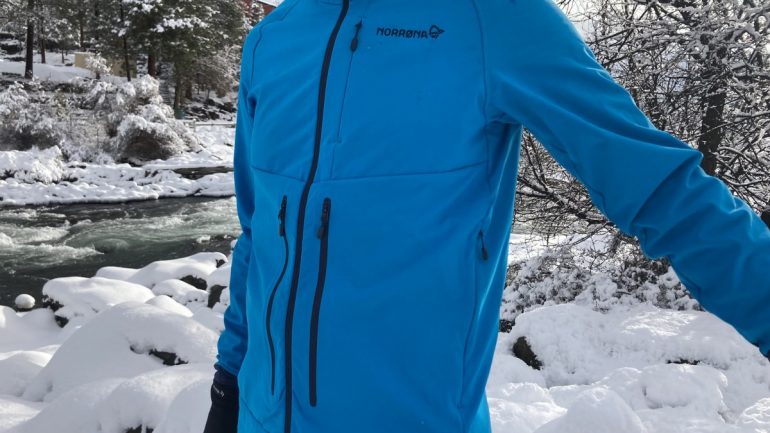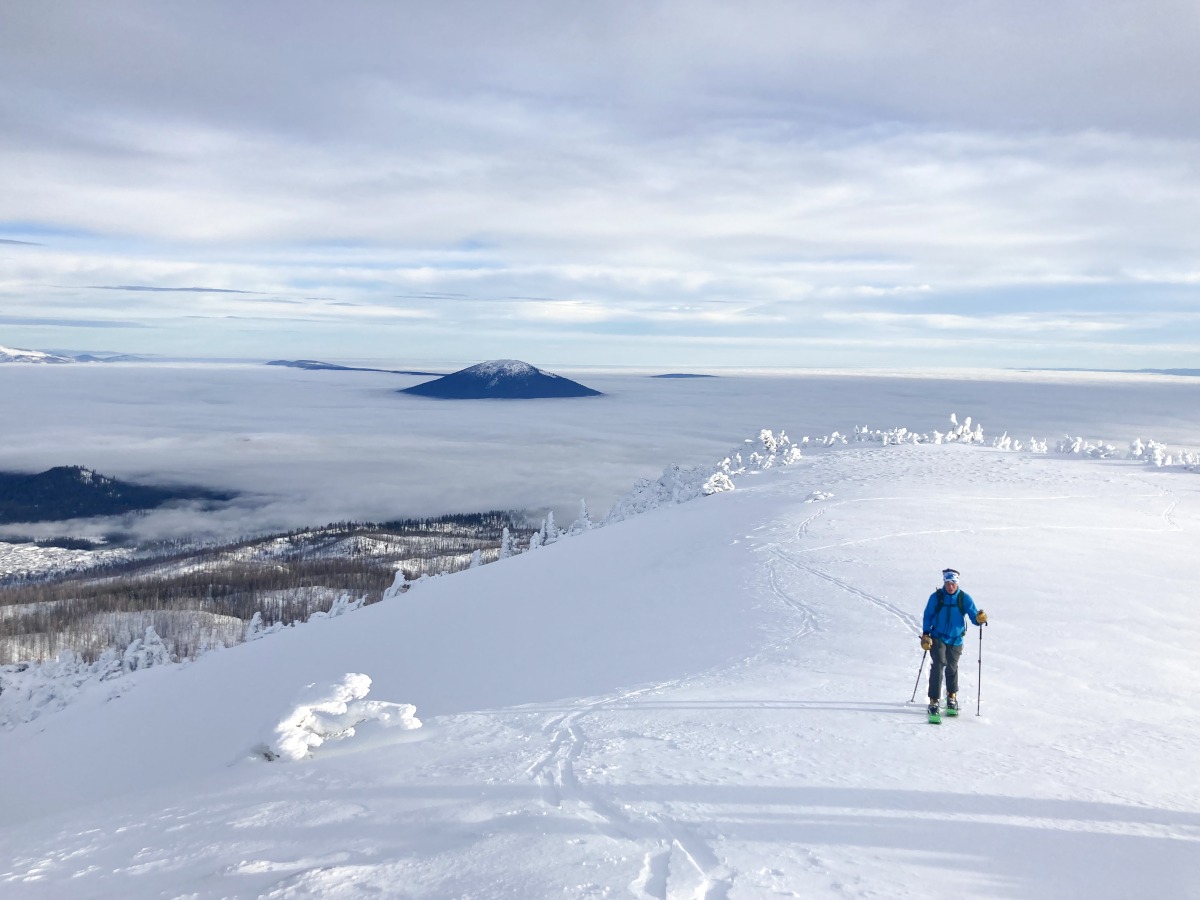
Cooler temps, little wind, no precipitation, dust on crust: a good day for the the Norrona Hiloflex100 softshell jacket.
With the proliferation of softshell jackets on the market, defining the category is getting harder. Some are paper-thin, best for wind protection during highly aerobic activities; others are thick and durable with a water-resistant membrane. Many integrate a modest fleece insulation for warmth. Softshells have become specialists like skis designed for a narrow range of snow conditions. By definition, they all prioritize breathability over waterproofness, but that’s a pretty coarse filter. If you are looking for a quiver killer jacket that nicely balances breathability, warmth, and water resistance, the Norrona Lyngen Hiloflex 100 Jacket is worth considering.
The Norwegian brand makes a range of outdoor apparel and gear with three distinct lines. The Lyngen category is designed specifically for ski touring, and the Hiloflex 100 is that category’s softshell jacket. Interestingly, the company calls the Hiloflex 100 a mid-layer, but to my eyes, it is an outer shell for most conditions.
I have worn the Hiloflex 100 on roughly 10 ski tours in conditions ranging from the upper 20s and calm to single digits and windy. For skiers accustomed to using a thin shell over an insulated mid- or baselayer, the Hiloflex 100 takes some getting used to. Much of the Hiloflex 100’s fabric is a stretchy, medium-weight woven material. The outer face is a durable, wind-resistant stretch woven that feels similar to other softshells on the market. The inner material is a light and soft fleece that feels buttery to the touch. It’s that inner insulating layer that makes you plan your other layers carefully.
On all but the coldest days, I typically wear a Patagonia R1 or its equivalent under a thin windproof (but not waterproof) shell. I run warm, so I like a breathable layer to keep me comfortable. I first used the Hiloflex 100 on a day of doing laps on an 800-vertical-foot slope in temperatures in the upper 20s. With an R1 underneath, the Hiloflex 100 was too warm, but it did a great job of moving moisture.
In similar conditions, the next time around, I wore a thinner base layer (Patagonia Midweight Capilene), and the combination was perfect. The light fleece on the inside of the Hiloflex 100 worked well with the relatively thin baselayer to keep me comfortable all day.
On my most recent outing, I toured in 15-degree temperatures on a breezy day. I returned to the R1 baselayer under the Hiloflex 100, and broke trail in knee-deep snow. Despite the strenuous effort, I never overheated. In short, this jacket is awesome if you dial in your base layer. And depending on your thermoregulation specifics, a thinner or thicker baselayer may work best for you while wearing the Hiloflex 100.
One reason the Hiloflex 100 breathes so well is that it incorporates an open-construction fleece panel on the back. Though much of this panel is covered by a backpack when ski touring, the material wicks moisture better than the outer, stretch-woven material.
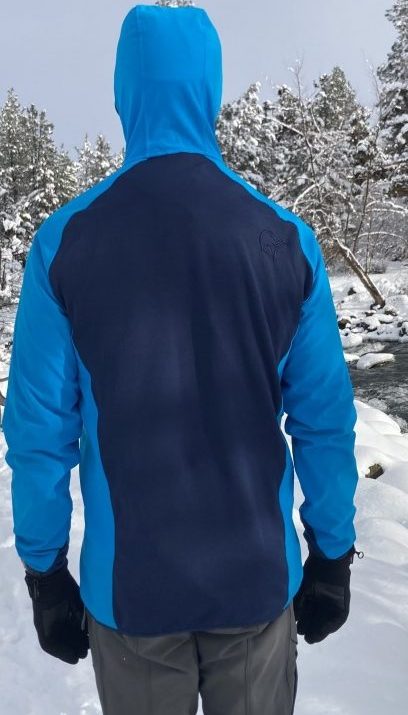
The jacket runs past the waist (and slightly longer in the back). The navy fabric is a more breathable less wind-resistant back panel.
The folks at Norrona did a nice job designing features that work well for backcountry skiing. The jacket features an extended cut with no way to tighten the hem around the waist. At first, I thought this was a flaw, but after several tours, I liked having the extra length to ensure that the hem didn’t ride up above the waistbelt of my pack.
The Hiloflex 100 has two front pockets and one smaller chest pocket. The front pockets are set high enough to remain out of the way of a waistbelt or harness. Each of these pockets has zippered entries on the front and on the side. In truth, I didn’t notice the side entries until I’d used the jacket several times. The front entries are so convenient that I doubt I’ll ever use the others. The pockets themselves are designed to hold skins while descending and have a waterproof lining facing the body to protect the skier’s body from wet skins. The chest pocket is pretty standard fare, but it comfortably holds my phone and is easy to access without unclipping the sternum strap on my pack.

The lower pockets feature two entrances, both zipper accessed. Enter from the side to warm the hands or the close-to-center access to stuff skins into the weatherproofed pocket.
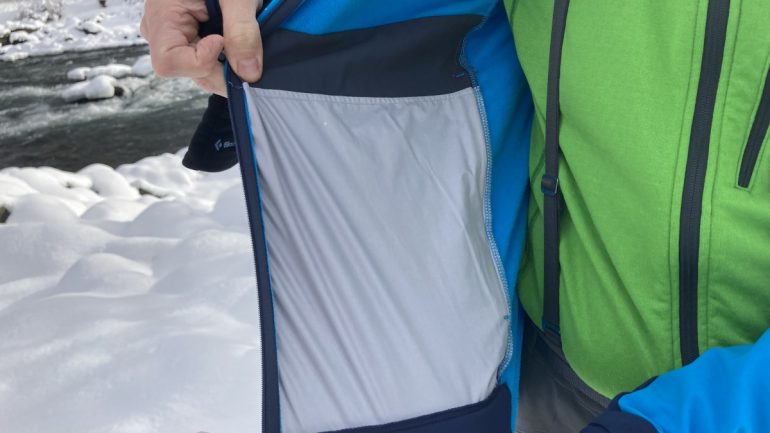
The inner lining on the two lower pockets is backed with waterproof fabric. A nice design feature for those who stuff skins into pockets for quick transitions.
If you like thumb loops on your sleeves, you’re in luck. The Hiloflex 100 incorporates stretch lycra cuffs with holes for the opposable digit. And though I find that thumb holes get in the way of my GPS watch, the cuffs themselves are incredibly comfortable and provide an excellent interface with the rest of the sleeve.
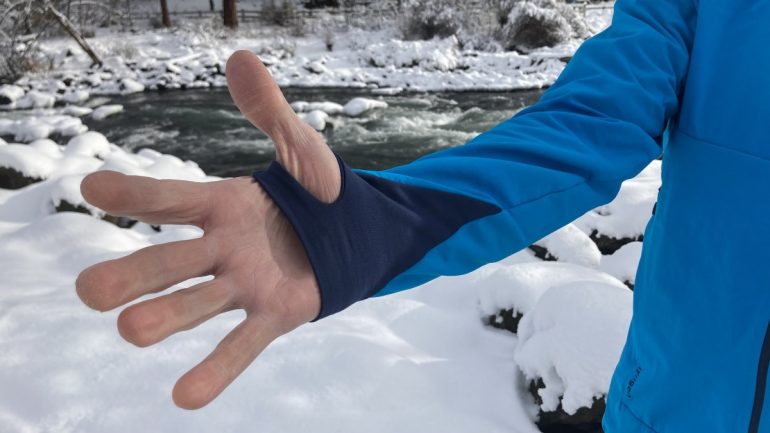
For those that love them, the Hiloflex100 has thumb holes for a more secure fit and slightly warmer hands.
Because Norrona developed the Hiloflex 100 as a middle layer that can function as an outer layer on dry days, the hood is slim and simple, designed to wear under a helmet. For that reason, it has no tightening mechanism. The trim, stretchy hood fits snugly around your head, obviating the need for a hooded baselayer. Because I’m more likely to wear this jacket as an outer layer, the hood is not ideal. It does fit over my helmet, but uncomfortably so.
So far, throughout this Winter, the Norrona Hiloflex 100 has become my go-to outer layer for ski tours. After I learned to wear it with a slightly thinner baselayer, and let the Hiloflex 100 do some insulating work, I have found it to be a versatile softshell that performs.


